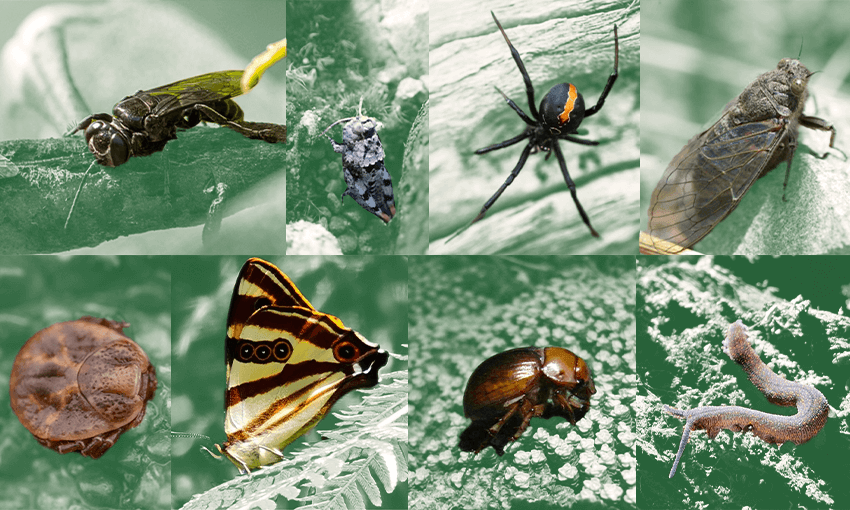Marcia Welch presents some of this year’s most loveable candidates for Bug of the Year.
If you thought the deep longing for connection was reserved for just the human species – think again. There are thousands of single bugs in Aotearoa, and they’re all looking for love. Twenty of them are in the running for Bug of the Year.
They’re finding dating particularly difficult in this climate, thanks to their dwindling population numbers, introduced predators and, of course, the actual climate. But based on their Tinder profiles, the 2024 candidates have a lot to offer (if you’re wondering why bugs don’t use Bumble, your guess is as good as mine).
Most people don’t like bugs, let alone picture what it’d be like to date one. But, according to science, this is an easy and effective way to reduce the likelihood of dooming them to extinction (source unknown). And unlike human Tinder, the prospects are far less terrifying.
Last year, the Entomological Society raked in a whopping 17,000 votes and crowned ngaro huruhuru, our native bee, as the winner. This year, they’re hoping for more. The bigger this competition gets, the more likely it is to be railroaded by a Brit who has no business meddling in New Zealand politics. They could do with this level of exposure because while a black cockroach-hunter wasp may not win a beauty pageant, she could win your heart.
Minute grasshopper
The minute grasshopper is the smallest in the Acrididae family and is not to be confused with the minute grasshopper, who only lasts sixty seconds. They’re great at camouflaging, and won’t even make a dad joke about it.
Katipō
For whatever reason, red flags and spiders get a bad rap (I personally love them both). Luckily, for you, the katipō is just a spider. And when I say just a spider, I mean she runs a successful gin distillery in her spare time, lobbies for dune restoration in coastal habitat, and, despite the rumours, didn’t kill her late husband. Intimidating? Yes. Red flag? No. Don’t let your inferiority complex cloud your better judgment.
Tuatara tick
As the name suggests, the tuatara tick is still in love with their ex. So much so that they took tuatara as their first name instead of their last name when they married. Attachment style: avoidant, which is ironic given it’s parasitic. But you know you’ve found someone special when they can be physically attached, seeping the life force out of you, yet you still feel alone. If you’re cold-blooded, this is a match made in heaven.
Scree cicada
Scree cicadas are easy to identify because they’re the only New Zealand cicadas to exclusively wear Patagonia and North Face. Their ideal first date would be summiting Everest, watching Free Solo or showing you their carabiner collection. If you love adventure, go hard, but prepare to be cardiovascularly challenged.
Ngaro wīwī – Black cockroach-hunter wasp
Despite being wasps, these little cuties won’t bite or sting you. She has wings to reach the top shelf, can open any jar and will catch cockroaches for you. Need I say more?
Cromwell chafer beetle
The only place in Aotearoa (and the world) where you can find this beetle is in the Cromwell Chafer Beetle Nature Reserve. If you don’t know where Cromwell is, just put “gentrification” or “big fruit” into Google Maps. This 81-hectare reserve was established in 1979 solely for their protection. Pros: he owns a boat and drives a Land Rover. Cons: he lives with his mum and the entirety of his species, so good luck getting any privacy.
Pepe pouri – Forest ringlet butterfly
Look familiar? You’ll recognise this butterfly from that letter you sent in 1991. Other than gracing that postage stamp that one time, the forest ringlet also stars on those “have you seen me? I’m really endangered” posters. Please refrain from licking them, their entire genus is at risk of extinction, so they’ve got enough to contend with. While they’re way out of your league, if you do find one, never let them go – and report it to iNaturalist.
Ngāokeoke – New Zealand velvet worm
There’s a reason the ngāokeoke has remained virtually unchanged for 500 million years. It’s because they’re perfect. Marry them.
Voting for Bug of the Year closes on Monday 12 February and the winner will be announced on Valentine’s Day.

